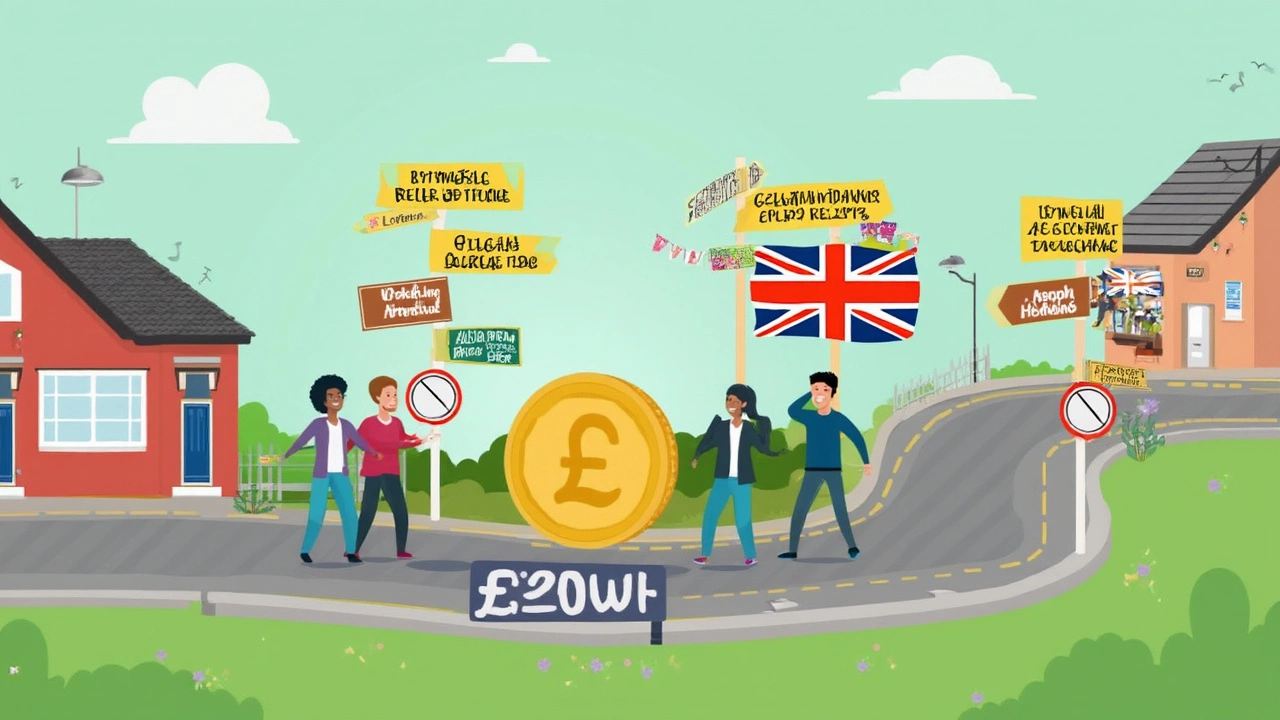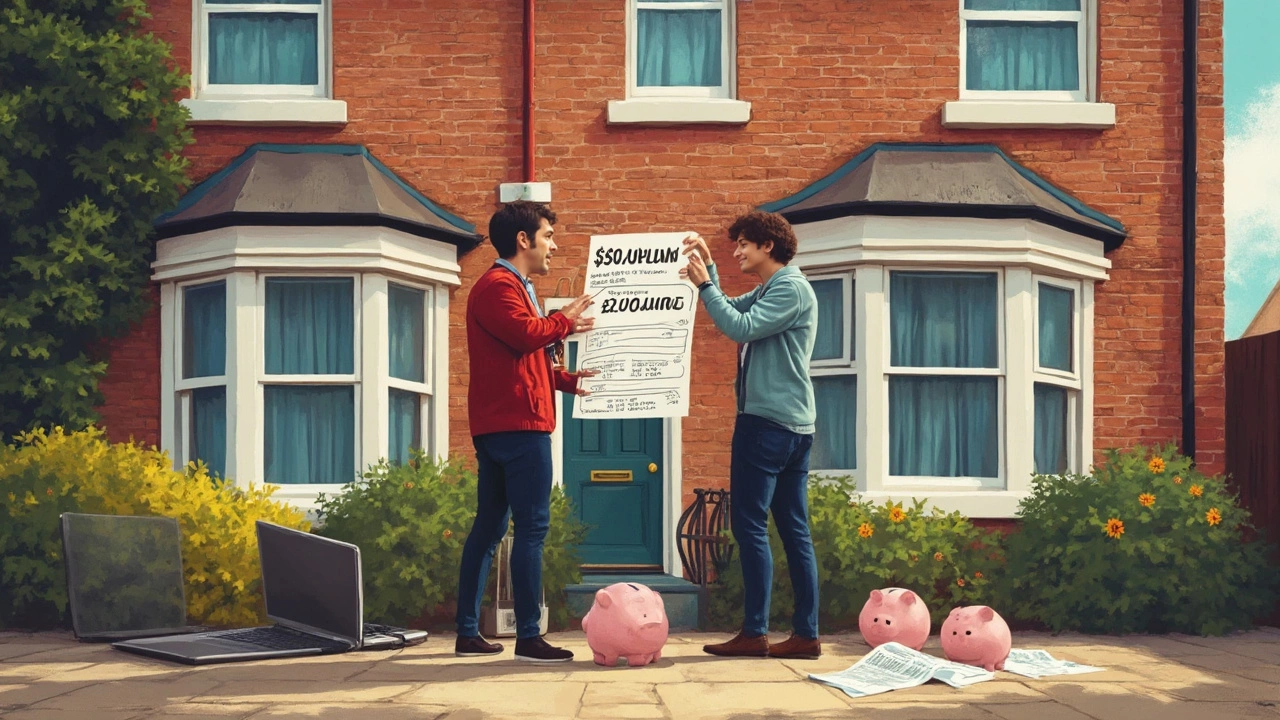Thinking about buying your first place and got $20,000 saved? You’re already ahead of the game compared to a lot of folks, but the real question is: how far does that actually get you? Home prices and lender rules have changed a lot in the last few years, so $20,000 might mean something very different depending on where you’re looking—and what kind of loan you’re hoping to get.
Most lenders want at least a certain percent down, like 3% to 5% for first-timers with decent credit. But if you’re eyeing houses in areas where the starter home hovers around $300,000, your $20,000 covers just under 7%. In super pricey cities, it won’t stretch quite as far. That said, $20,000 can still open doors to several loan options, and it might be enough to ditch private mortgage insurance sooner—or lower your interest rate.
But wait, there’s more to it than just the check you hand over at closing. Some loans require less down but charge you extra each month (PMI, anyone?). You’ll want to think about not just how much house you can buy, but how to keep your monthly payment healthy. And hey, don’t forget closing costs—on average, people spend about 3% extra when sealing the deal. So that $20,000 could shrink fast if you use it all for the down payment.
- What Does a $20,000 Down Payment Get You?
- How It Affects Your Mortgage and Monthly Payments
- Loan Types and Minimum Down Payment Rules
- Is $20,000 Enough in Today’s Market?
- Tips to Make Your Down Payment Go Further
What Does a $20,000 Down Payment Get You?
$20,000 sounds like a ton of money, but how much house does it actually get you in 2025? The answer depends on local prices, lender rules, and what type of mortgage you’re using. In most parts of the country, the typical first-time buyer home price is anywhere from $250,000 to $400,000. If you aim for the middle—let’s say $300,000—putting $20,000 down means about 6.7% down.
For folks using FHA loans, which are super popular with first-time buyers, the minimum down payment is 3.5%. VA and USDA loans might need as little as 0% down, but you have to qualify. The standard conventional loan wants at least 3%. So with $20,000, you’re not just meeting the bare minimum—you’ve got a little buffer, especially if you shoot for homes under $400,000.
Now, why does this number matter? A bigger down payment can help in a few key ways:
- You can buy a pricier home or stay below the 20% PMI threshold faster, which saves you money in the long run.
- Sellers may view your offer as stronger because you’re putting more skin in the game.
- You’ll borrow less, which keeps your monthly payments down—freeing up money for stuff like furniture, emergencies, or even that pizza night after move-in day.
Across the U.S., stats show most down payment amounts for first-time buyers average just about 6%, so $20,000 puts you right in line or even ahead in plenty of markets. Of course, if you’re looking somewhere like San Francisco or New York, $20,000 probably won’t get you too far unless you find a tiny condo or go in with others. But for a ton of places, it unlocks a good chunk of options—and gives you negotiating power that a bare-bones down payment won't.
How It Affects Your Mortgage and Monthly Payments
So, you've got $20,000 locked and loaded. Here’s where it gets real: your down payment size can seriously change what you pay each month. First, let’s talk about why lenders care. The more cash you put down up front, the less risky you look in their eyes. That can mean a lower interest rate and a smaller loan overall.
Let’s break it down with a quick example. Say you want a $300,000 house. A $20,000 down payment is about 6.7%. If you go with a 30-year fixed-rate loan at 6.5% interest—totally common in 2025—your numbers might look like this:
| Home Price | Down Payment | Loan Amount | Estimated Monthly Payment (P&I) |
|---|---|---|---|
| $300,000 | $20,000 (6.7%) | $280,000 | $1,770* |
*Doesn’t include taxes, insurance, or PMI
Now, here’s the thing: if you put down less than 20%, almost every lender will tack on PMI (private mortgage insurance). That’s an extra monthly cost—usually $100 to $250—or sometimes more if your credit score isn’t amazing.
The size of your down payment also affects how much you need to borrow, which can influence your approval odds. If your payment eats up a big chunk of your income (lenders call it your "DTI" or debt-to-income ratio), you might not qualify for the home you want. Every dollar down helps shrink your loan, bringing your monthly payment down a bit and possibly making the difference between a yes or a no from the bank.
- Bigger down payment = lower loan = smaller monthly bill.
- Less than 20% down? PMI gets added to your payment until you build up enough home equity—usually when you hit that 20% mark.
- Better down payment can sometimes snag you a slightly lower interest rate, saving you thousands over the life of the loan.
Quick tip? Use an online mortgage calculator before you shop. Plug in your numbers. Compare different down payment amounts and see how fast those monthly payments change. That gives you the real picture of what you’ll actually pay, not just a ballpark number from ads.

Loan Types and Minimum Down Payment Rules
Not all mortgages work the same way, so your $20,000 down payment can mean different things depending on the loan you pick. Here's what you really need to know about minimum down payment rules for the most common types of home loans.
- Conventional Loans: These are the "regular" loans most lenders offer. For first time buyers, you can often get by with as little as 3% down—if your credit score makes the cut. For a $300,000 house, that's $9,000. Keep in mind, though, that putting down less than 20% triggers private mortgage insurance (PMI), which bumps up your monthly payment.
- FHA Loans: Backed by the government, these loans are a big favorite for first timers. The minimum down is 3.5% if your credit score is at least 580. So, for that same $300,000 house, you’re looking at $10,500.
- VA Loans: If you've served in the military, this option can be a game changer—potentially zero down payment, no PMI, and some of the lowest rates around. Not everyone qualifies, but if you do, your $20,000 could cover closing costs or upgrades instead.
- USDA Loans: Buying in a rural area? This program, designed for lower-income and rural buyers, can also offer zero down options. The catch is you’ve got to meet income limits and the property has to be eligible.
Here’s a quick look at how that would break down on a $300,000 house:
| Loan Type | Minimum Down Payment | PMI/Insurance? |
|---|---|---|
| Conventional | 3% ($9,000) | Yes (if under 20% down) |
| FHA | 3.5% ($10,500) | Yes (required MIP) |
| VA | 0% ($0) | No |
| USDA | 0% ($0) | Yes (guarantee fee) |
The most important thing? Lenders always look at your credit score, debt, and the kind of property you want. The rules above are typical in 2025, but there can be surprises. Always check the exact numbers with your lender before you fall in love with a place.
Is $20,000 Enough in Today’s Market?
A few years ago, $20,000 could easily get you a solid starter home down payment in many cities. Fast forward to 2025, and things look a little different. The median price for a U.S. home now sits just over $390,000, according to the National Association of Realtors. That means your $20,000 is about 5% down on a typical house—not too shabby for a down payment, but maybe tighter than you hoped.
It really comes down to where you're buying. In places like Texas or Ohio, where home prices often hang around $250,000, a $20,000 down payment lands you close to 8%. But in big coastal cities—think Los Angeles or Seattle—starter homes can easily be over $600,000. There, $20,000 is more like a drop in the bucket, covering only around 3%.
You also have to factor in competition. A lot of sellers expect buyers to put more money down to show they're serious, especially if you’re house hunting in a hot market with bidding wars.
"Buyers with less than a 20% down payment aren't out of luck, but they may face steeper monthly costs and tougher competition," says Hannah Jones, senior economic analyst at Realtor.com.
Here’s how that math shakes out in 2025 for typical first-time buyer homes around the country:
| City | Median Home Price | $20,000 as % Down |
|---|---|---|
| Houston, TX | $282,000 | 7.1% |
| Tampa, FL | $320,000 | 6.3% |
| Cleveland, OH | $195,000 | 10.2% |
| Seattle, WA | $670,000 | 3.0% |
| Los Angeles, CA | $780,000 | 2.6% |
So, is $20,000 enough? It can be—sometimes even a bit more than the bare minimum you need, especially in lower-cost areas or with government-backed loans. The catch? You'll probably pay extra each month for mortgage insurance if your down payment is under 20%—though some buyers consider that a small price to get in the door.
- If you’re aiming for a conventional loan, $20,000 usually meets the minimum in most spots.
- In high-cost cities, you might need to look for smaller homes, condos, or even explore assistance programs to boost your buying power.
- Using all $20,000 as a down payment is tempting, but don’t forget you’ll need cash for closing costs and a cushion for emergencies.
Bottom line: $20,000 is enough to get started in many places, especially if you’re flexible on where and what you buy. It all depends on the market and the loan you choose.

Tips to Make Your Down Payment Go Further
If you’re staring at your savings and wondering how to stretch that $20,000, you’re not alone. There are legit ways to get more out of every dollar, and a few of them might even surprise you.
- shop around for lenders: Not every bank has the same rules. Some lenders work with first time buyers to get loans with low down payments, especially if you're using an FHA or VA loan. A little comparison shopping can shave off thousands over the life of your mortgage.
- Ask about down payment assistance programs. In 2025, dozens of states and cities offer help for first-timers, like grants or forgivable loans. Search for programs specific to your area—they can add thousands to your front-end cash.
- Negotiate with the seller. In some markets, especially where homes aren’t selling super fast, you can ask the seller to cover part of your closing costs. That way, you can keep more of your $20,000 toward your actual down payment instead of fees.
- Check if you qualify for private loans or gifts from family, which don't trigger a tax penalty under certain limits (the IRS lets folks give up to $18,000 per person per year in 2025 without tax headaches).
- Don't use every penny. Make sure to keep at least a small emergency fund. New homeowners often face surprise expenses—appliances break, something leaks, moving costs more than you thought. Experts at Freddie Mac suggest keeping at least three months of living expenses available after closing.
Bottom line: Leverage your options, be nosy about local and national programs, and don’t leave money on the table. Stretching your $20,000 isn’t just smart—it can lower stress and help you hold onto your new home for good.
